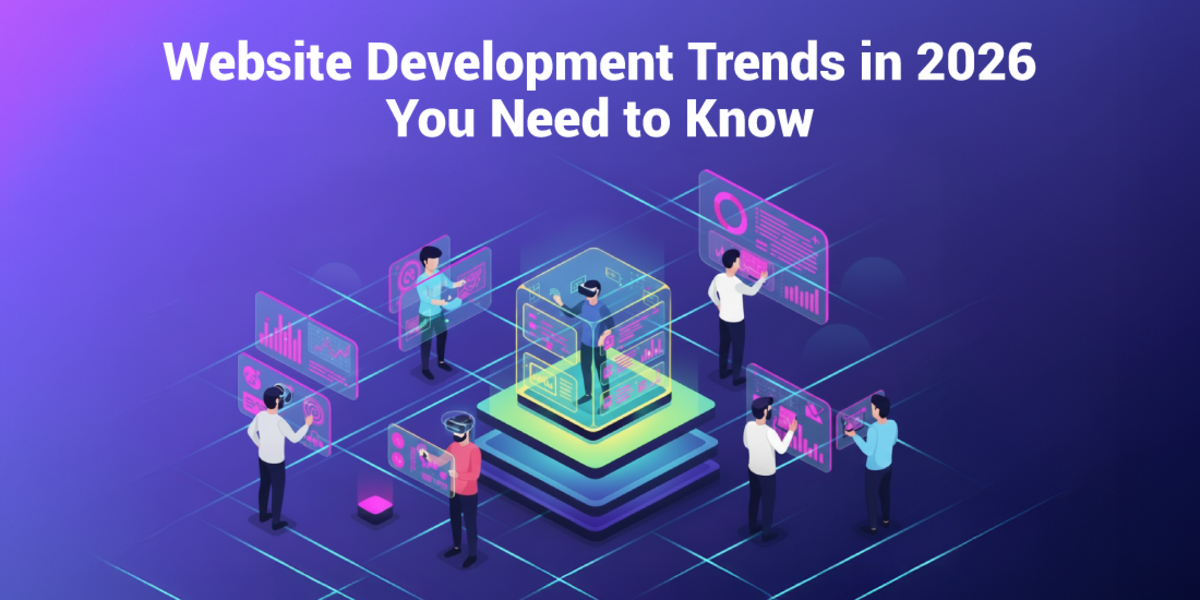WordPress and the Metaverse: Building Experiences for the Future Web
- By Rushik Shah
- 19-02-2024
- Web Development

WordPress has quickly established itself as an industry-leading content management system, powering millions of websites worldwide across industries and sectors. Renowned for its user-friendly experience, extensive plugin library, and customizable theme options - WordPress remains an attractive solution for both individuals and businesses looking to establish online presences.
Technology continues to advance and with it our expectations and interactions within the digital sphere. With its recent advent comes an evolving definition of what the "Metaverse" represents; an evolution from science fiction that envisions an expansive virtual space where users can collaborate seamlessly while also experiencing immersive exploration environments.
At its core, the Metaverse defies traditional boundaries by blurring physical and digital realities. It includes virtual worlds, augmented reality experiences, social networks and more interconnected through an expansive digital infrastructure - providing users with seamless transition from browsing a website to participating in a virtual conference, art gallery visit or shopping marketplace within one interlinked ecosystem.
Integration between WordPress and the Metaverse holds enormous promise to transform web experiences for years to come. By harnessing Metaverse technologies, WordPress users can unlock endless new avenues for creativity, engagement, and interactivity on their sites. From immersive storytelling experiences and product showcases to virtual events and social interactions, the synergy between WordPress and the Metaverse offers insight into a future frontier of content production and consumption online. This evolving landscape opens up significant opportunities for WordPress development, enabling developers to craft unique experiences that blend the digital and virtual worlds seamlessly.
Understanding the Metaverse
The Metaverse represents an unprecedented transformation of our digital environment, altering how we perceive and interact with virtual environments. At its heart lies an expansive virtual space known as "The Metaverse." Not bound by one single website or app but connected via digital infrastructure networks consisting of diverse immersive experiences interlinked through interlinked digital infrastructure networks, this vast virtual realm exists as part of everyday reality for us all to experience.
Imagine entering an unfathomably vast virtual universe where physical reality and virtual reality coexist seamlessly. Within this virtual realm, users can explore, interact with and create in ways previously inconceivable. The Metaverse isn't simply a static collection of websites or applications - rather, it provides a dynamic ecosystem which encourages collaboration, creativity and community building.
At the core of the Metaverse is immersion. While most online experiences tend to feature two-dimensional interfaces, immersive environments like the Metaverse give users full sensory engagement - from virtual worlds and augmented reality experiences, to simulations, social networks, interactive simulations and social simulations, this platform creates multi-sensory encounters for an unforgettable experience.
Central to the concept of the Metaverse lies its accessibility. Unlike virtual reality experiences that require special hardware or software, which only certain individuals have access to, the Metaverse is accessible online via any internet connection, making it accessible by anyone from around the globe regardless of geography, socioeconomic status or sexuality. Through this democratized form of accessing it all participants in its communities may participate. This ensures its inclusive nature is maintained.
Furthermore, the Metaverse can be defined by its interconnection. Just as the internet connects millions of websites and users worldwide, so too does its virtual environment connect virtual environments, experiences, communities and societies, creating smooth transitions from different digital spaces. Such interconnectivity encourages collaboration and communication by connecting people together online while sharing ideas or working on collaborative projects simultaneously in real-time.
The Role of WordPress in the Future Web
WordPress stands as the cornerstone of modern web development, featuring an accessible user-interface and robust plugin ecosystem, with themes suitable to almost every design preference. As an open-source project it has created an active community of developers, designers and content creators which has played an instrumental role in its continual evolution and adaptability - becoming even more essential as we enter an age marked by Metaverse development.
WordPress: A Brief Overview
1. Flexibility and Ease of Use
WordPress's architecture allows for extensive customization and scalability. No matter if it's for personal blogging, corporate websites or eCommerce stores, WordPress can meet any need with its customizable platforms and intuitive dashboard. WordPress makes itself accessible even to people without technical background - perfect for new users starting off.
2. Robust Community Support
The WordPress community is its greatest strength. Boasting millions of active users globally, the platform benefits from an ongoing influx of themes, plugins and updates developed through community efforts that ensures WordPress remains at the cutting-edge of web technology, security measures and best practices.
3. Powering a Significant Portion of the Web
WordPress's widespread usage demonstrates its capabilities and reliability. Powering over 40% of websites online, WordPress is clearly an industry leader when it comes to CMSs; being suitable for everything from small personal projects to large enterprise sites makes WordPress the go-to solution for a range of web development requirements.
Integrating WordPress with the Metaverse
1. Opening Up a Realm of Possibilities
The Metaverse represents an exciting new frontier of digital interaction, merging virtual reality (VR), augmented reality (AR), blockchain technologies and WordPress into immersive, interconnected environments that meld digital interaction seamlessly. Integrating WordPress with this immersive space means taking advantage of its strengths to build and manage these virtual spaces - which provides websites or applications which operate or interact within or interface with Metaverse as a solid development base utilizing WordPress as their backbone platform.
2. Accessible, Customizable, and Engaging Virtual Experiences
One of the most exciting prospects of integrating WordPress with the Metaverse is the democratization of virtual space creation. WordPress's intuitive user-interface and extensive customization features enable the creation and management of virtual environments to become as straightforward as running any traditional website. It opens the doors for content creators, developers, entrepreneurs to participate more fully in creating virtual realities - broadening out and diversifying its ecosystem with diverse experiences and viewpoints.
3. Technical Foundations for Integration
The technical infrastructure of WordPress, including its REST API, allows for seamless integration with various technologies pivotal to the Metaverse. For instance, WordPress sites can serve as portals to virtual environments, manage digital assets using blockchain technology, or provide interfaces for VR and AR experiences. Furthermore, the plugin ecosystem could grow to encompass tools specifically created to integrate Metaverse environments, like VR content editors or cryptocurrency payment gateways.
4. Challenges and Opportunities Ahead
Integrating WordPress and the Metaverse presents its own set of challenges. Addressing issues related to data security, user privacy and the technical demands of real-time 3D environments require innovative solutions; but the potential rewards - wider access to virtual spaces, new forms of online interaction and the merging of digital and physical reality -- present exciting prospects for web's future development.
Technologies Paving the Way
As we examine the technological foundation of the Metaverse, three core technologies emerge immediately: Virtual Reality (VR), Augmented Reality (AR) and Blockchain/Cryptocurrency. Each plays an essential part in shaping its respective part of digital environments by offering new ways for interaction, transacting transactions and experiencing digital environments.
Virtual Reality (VR)
1. Immersive Digital Worlds
Virtual Reality technology lies at the center of Metaverse experiences. By wearing VR headsets and equipment, users are transported into fully digital worlds that mimic real life experiences - offering users the chance to explore, engage with, interact with content that mimics real life scenarios - but still seem real enough. VR's power lies in creating this illusion that convinces users they really exist within these virtual realities.
2. Applications in the Metaverse
Within the Metaverse, VR serves multiple functions. VR can create immersive environments in which users can engage in various forms of activity ranging from gaming and social gatherings, virtual tourism and educational programs, simulations for learning purposes that would otherwise be inconceivable in physical reality, all the way up to simulations for teaching purposes that wouldn't otherwise exist otherwise. VR's immersive nature also makes it a fantastic platform for experiential learning by creating situations which wouldn't otherwise exist outside virtual reality settings.
Augmented Reality (AR)
1. Enhancing the Physical World
Augmented Reality technology bridges the divide between virtual and physical worlds by projecting computer-generated images, sounds or data onto physical environments in real-life. Users using smartphones, tablets or specialist AR glasses can see and interact with this virtual augmentation as though it were part of their immediate environment.
2. Bridging Realities in the Metaverse
AR plays an essential part of the Metaverse by amplifying real-world experiences and blurring the boundary between virtual and real spaces. AR technology can be utilized both educationally (i.e. museum exhibits) or entertainingly, such as by adding digital elements to live events; retail applications of augmented reality allow customers to visualize products before purchase; AR is revolutionizing shopping in physical retail locations as customers can visualize products directly in their own living environments before making purchases; it expands opportunities for hybrid experiences by connecting users' physical lives seamlessly with their virtual counterparts while opening new horizons of interaction between physical and virtual realities through hybrid experiences connected by AR technology that allows seamless hybrid experiences seamlessly connecting users' physical lives seamlessly - giving rise to hybrid experiences that bring both worlds together seamlessly!
Blockchain and Cryptocurrency
1. Secure Transactions and Ownership
Blockchain technology serves as a decentralized ledger that facilitates secure, transparent transactions within the Metaverse to manage ownership of digital assets like real estate, art pieces or in-game items. Cryptocurrencies use cryptography for security to facilitate these transactions enabling transactions without traditional financial intermediaries being needed for purchasing, selling and trading of assets.
2. Foundation for a Digital Economy
Blockchain and cryptocurrency provide the building blocks necessary for an open, accessible, and secure digital economy within the Metaverse. These aspects allow global users to take part; authenticity of digital assets ensured by Blockchain allows users to trust its virtual economy; smart contracts allow transactions and agreements to take place more seamlessly within this virtual economy; while automating transactions increases both efficiency and safety within it.
Enhancing User Experience in the Metaverse
Enhancing user experience within the Metaverse requires taking an integrated approach, taking into consideration both technical and creative elements of digital environment design. Our aim should be to craft spaces that are immersive yet intuitive and accessible - two key areas being User Interface (UI) Design and Immersive Content Creation.
User Interface Design
- Simplifying Navigation: The complexity of the Metaverse, with its vast, interconnected virtual spaces, presents unique challenges in UI design. Interfaces must be designed to help users navigate these complexities effortlessly. This involves creating clear, intuitive navigation systems that can guide users through the Metaverse without overwhelming them. Design considerations should prioritize user needs, taking into account different levels of experience and accessibility needs.
- Enhancing Interactivity: User interfaces in the Metaverse go far beyond simple menus and buttons - they encompass an extensive spectrum of interactions between a user and his or her virtual environment, from gesture recognition and voice commands, through to haptic feedback - giving a multisensory engagement that adds presence into virtual spaces. An effective UI designer must combine all these aspects seamlessly so interactions feel natural and intuitive for his users.
- Adapting to Different Environments: The Metaverse encompasses multiple environments with distinct rules, aesthetics and functionalities that each demand unique UI designs that can adapt seamlessly. User experience design must remain flexible enough to adapt with every unique space while keeping some element consistent to help users feel at home in all settings.
Immersive Content Creation
- Leveraging WordPress for the Metaverse: WordPress, commonly utilized for creating websites and blogs, can also serve as an effective platform for Metaverse content production. Utilizing its extensive plugin ecosystem and theme customization features, WordPress enables the production of immersive multimedia that extends far beyond text and images - such as 3D models, virtual tours and interactive storytelling experiences.
- Breaking the Boundaries of Traditional Content: Content creation within the Metaverse requires creating experiences that engage users through interactive narratives, from educational simulations offering hands-on learning opportunities to virtual exhibitions that give visitors access to art works in three dimensions. The aim is not simply for content to be consumed passively but actively experienced, encouraging exploration, interaction, and engagement between user and creator alike.
- Integrating Multimedia Elements: Metaverse's strength lies in its ability to weave various media forms together into an immersive experience, using plugins or custom development services as needed to incorporate video, audio, 3D animations and interactive elements. WordPress creators can leverage plugins or custom development services in order to integrate video, audio, 3D animations and interactive features seamlessly into their content, providing richer, more captivating experiences that invite deeper exploration of the Metaverse universe.
Conclusion:
WordPress and the Metaverse have come together to pave a new digital pathway, offering unparalleled opportunities for immersive and engaging digital experiences. At the threshold of this exciting digital era lies immense scope for innovation, connection, and exploration - an era which may yet prove transformative!


.jpg)


